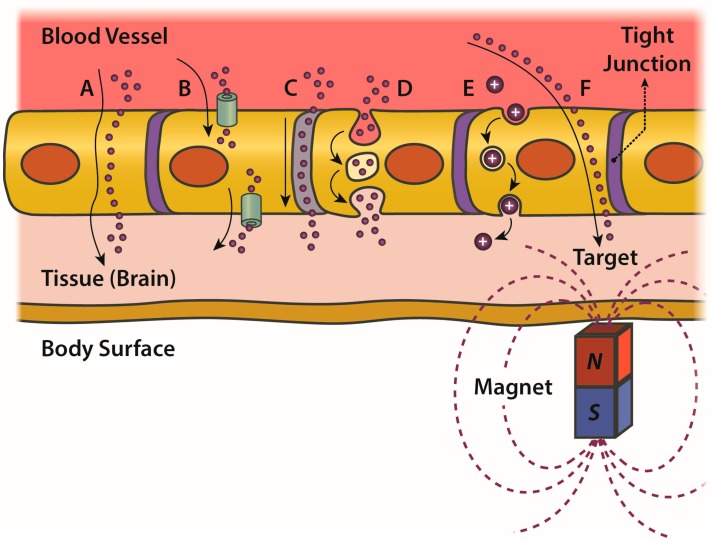Figure 3.
Schematic enumeration of the many pathways which a compound can use to cross the blood-brain barrier, depending on its chemico-physical properties. (A) Drugs can cross the barrier simply by passive diffusion if they are sufficiently lipid soluble (or have been made lipophilic by appropriate chemical modifications); (B) Carrier protein-Mediated active Transport (CMT) can allow many essential compounds such as glucose and amino acids to enter the endothelial cytoplasm and then be released into the brain at the abluminal side. In addition, artificial compounds mimicking those endogenous ligands have been developed to take advantage of the carrier-mediated transport mechanisms; (C) Drugs or even NPs can enter the brain through a paracellular route only when the tight junction system is disrupted. In particular, BBB permeability can be temporarily induced in several ways: by local temperature increases (38–39 °C), by osmotic alterations (e.g., infusion of hypertonic solutions of mannitol), by adenosine receptor activation, by Focused Ultrasound (FUS) bombardment or by electromagnetic radiations; (D) The binding of specific ligands to the receptors mediating the endocytosis (e.g., transferrin and insulin receptors) allows the uptake of large compounds and NPs conveniently functionalized. By a subsequent exocytosis process, vesicles can then release their content at the abluminal side (RMT); (E) If the compound has sufficient cationic charge, it can induce a localized electrostatic disruption of membrane phospholipids resulting in the so-called Adsorptive-Mediated Transcytosis (AMT); (F) If the drug is carried by NPs exhibiting magnetic properties (such as IONs) a localized magnetic field, generated by an external electromagnet, can be used to produce a driving force enabling the passage of such NPs from the bloodstream to a targeted region of the brain (through both paracellular and transcellular routes).

